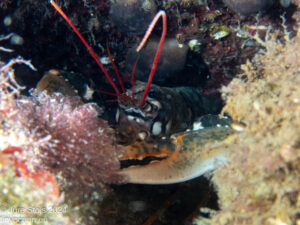I did a few dives in February, March, and April in Fiesa and I decided to group everything into one post. The visibility was quite poor which means I didn’t get a lot of usable pictures. I noticed the visibility slowly decreasing from the end of January and it was just over 1 meter in April. By that I mean how far away I was able to see clearly, but I could make out a diver at about 2 meters.
I think the reason for poor visibility is partially due to the sandy/silty bottom as well as a few storms and a quite constant temperature over the whole depth. This means that the particles just stay suspended and don’t move.
The water temperature slowly rose from 10°C to 15°C and the weather outside also improved. Even though the visibility was getting worse there was still quite a bit to see.
I did more than one dive in February and I did a separate post about one. You can find it here: Fiesa – 3.2.2024
Cnidaria and Ctenophora
There were quite a few barrel jellyfish (Rhizostoma pulmo). While they are usually quite big, one of them was particularly large. I would say it had a diameter of 60 cm if not more. I also took a short video of one and it was going quite fast.
Of course, there are also a few pictures.
Keeping with the theme, a picture of a jellyfish Neoturris pileata. It was quite small, around 15 mm in diameter. The picture came off quite poor due to suspended particles.
I finally managed to get a decent picture of a comb jelly (likely Bolinopsis vitrea). When illuminated just right their bioluminescence glows up. In the photo below I set up my flash so that I was illuminating it from the top font side. This means the comb jelly was between my camera and the flash. This is usually easier with another diver helping you.
Arthropods
You can always see plenty of crustaceans but I usually look for less common ones. In the first two pictures is a European or common lobster (Homarus gammarus). The ones in the pictures were quite small.
Next are two examples of nocturnal animals. The sponge crab (Dromia personata) is interesting as they carry sponges with them as a means of camouflage. Sometimes they have quite impressive ones. Black squat lobsters (Galathea squamifera) are usually difficult to photograph. However, I have found that if you stop and wait for a bit of time before starting to take pictures, they quite often wait for a bit of time. That is if they don’t immediately hide in a hole.
I also got a chance to see quite a few nudibranchs. Here are two examples of a Felimare picta. I got a chance to get decent macro shots of their gills as well. They often retract them but if you wait a bit they sometimes relax and extend them back out.
Nudibranchs
Highlight od the dive
And I saved the best for last, the long-snouted seahorse (Hippocampus guttulatus). I am always extremely glad to see one, especially in yellow color. They blend in quite well but if you know where and what to look for you have a decent chance of finding it.
Conclusion
Even though it was winter I still managed to get a few dives in. As I only own a wetsuit I have to be a bit more mindful about conditions in and out of the water.
The conditions were fair to a bit poor in terms of visibility, but this is quite usual for Fiesa. Still, I managed to find a lot of interesting animals, you just need to take your time and observe.
With the weather improving, I think I will move my scuba diving to other locations now as well.













